Japan’s central bank has implemented a negative interest rate in an effort to lift that nation’s economy out of its lethargy. This has sent economists around the globe reaching for their history books to re-examine negative interest rates as an economic phenomenon as well as a monetary policy.
It’s a history that has its quirks and interesting side roads, certainly. One of them involved the use of cash machines.
The first cash machine in the United States, for example, was installed in 1969. Five years later Seattle First National Bank, at that time the largest bank in the state, introduced its first Automated Teller Machine (ATM) at one of its downtown banking locations. Several other ATMs were also installed and then the bank strategists waited to see if customers liked them.
The bank believed that people would use the machines if they found themselves needing cash during non-business hours. Credit cards were not in as near-universal use as they are today, and many restaurants, bars, shops and, especially, taxicabs, did not accept them, especially for smaller amounts.
The bank expected that there would be substantial withdrawals of cash, then, and to prepare for this the small teams of bankers that had been deployed on standby to repair any malfunctioning ATMs also were supplied with plenty of U.S. currency to refill the cash machine’s dispensing mechanism.
The response teams had plenty to do, at first, since the new machines were, well, new machines, and could be a little cranky. Both customers and machines soon got used to each other, though, and the number of repair calls dropped off dramatically.
What the teams almost never received were calls to replenish the cash dispensing mechanism. In fact, just the opposite was happening. Unexpectedly, the machines were taking in far more cash than they gave out.
Further investigations revealed that the primary motive for night-time usage was the need for safe-deposit facility where individuals or small businesses who regularly did business on a cash basis could safely park their accumulated revenue. Some, perhaps many, of these early adopters were entrepreneurs and workers in industries not normally the focus of banks’ marketing efforts and reflected the seedier and often dangerous dimension of downtown life after dark. During the night, these “early adopters” of the new technology were using the machines to deposit cash rather than withdraw it, paying a fee, essentially negative interest, for the service. (Some years later, some of these same groups quickly grasped the value of cell-phone technology and would become early adopters there as well.)
Day or night, downtown Seattle in the 1970s was hardly the Wild West, but its need for a safe, but accessible, place to stash money echoed the earliest days of banking in the U.S. and throughout history. Uncertain, insecure times created the demand and the heavy safes and vaults of early banks provided the supply to meet it.
The banks charged a fee for this service, of course, and this is one of the simplest examples of a negative interest rate. Instead of earning interest, money deposited for safe keeping runs up a parking fee. In today’s world safe deposit service fees, often called rental fees, are based on the amount of space used rather than the monetary value of the deposit, but that changes the effective interest rate calculation method, not the underlying principle of negative interest.
Negative interest rates are not often used by central banks, so the evidence of how effective they might be, especially in today’s global economy, is neither abundant nor compelling. The mechanics of how it usually works, though, are straightforward.
In the U.S. banking system, the Federal Reserve looks at regulating member bank reserves as a way to encourage or discourage commercial lending, which affects the money supply and the level of economic activity.
If the economy is stagnating, and interest rates are already at zero, it is still possible to encourage banks to lend money more freely by making it costly for them to keep excess reserves on deposit with the Fed — charging them interest for their “safe deposit” amounts. This “negative interest rate” is, essentially, the stick side of a carrot-and-stick policy approach, which lowers the cost of lending and increases the cost of not lending.
The commercial banks, of course, remain free to make their own decisions, and a lot of that depends on their assessment of their liquidity position, the lending environment in their market, and the availability of alternative strategies.
The U.S. economy is still some distance from stagnation — but is close enough for economists to be concerned about it. The Wild West is our past, not our future, but we could see negative interest rates come back, too.
James McCusker is a Bothell economist, educator and consultant. He also writes a column for the monthly Herald Business Journal.
Talk to us
> Give us your news tips.
> Send us a letter to the editor.
> More Herald contact information.

























